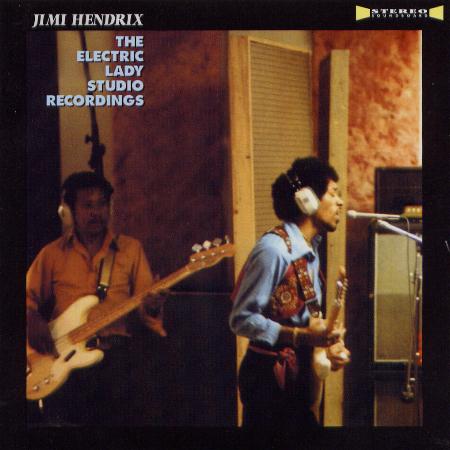
In 1968, Jimi Hendrix and his manager Michael Jeffery bought a newly defunct nightclub called The Generation located at 52 W 8th Street in New York’s Greenwich Village — a venue that Hendrix had frequented for impromptu performances and late-night jam sessions. The Generation had been known for live acts as diverse and legendary as Big Brother & the Holding Company, B.B. King, Chuck Berry, Dave Van Ronk, and Sly & the Family Stone.Instead of renaming the club and continuing with the live venue business model (Jimi’s original vision for the project), advisors Eddie Kramer and Jim Marron convinced Hendrix to convert the space into a professional recording studio. Architect, John Storyk, designed each structural detail, and from there the origins of New York’s famed Electric Lady Studios were born. It would be the only artist-owned recording studio in existence at the time.
On August 26th, 1970, Hendrix hosted the grand opening of his psychedelic studio lair to fellow musicians and friends. Guests included Steve Winwood, Eric Clapton, Ron Wood, and Patti Smith.
“I put on my straw hat and walked downtown, but when I got there, I couldn’t bring myself to go in,” recalls Patti Smith in her award winning memoir, Just Kids. “By chance, Jimi Hendrix came up the stairs and found me sitting there like some hick wallflower and grinned.
“He spent a little time with me on the stairs and told me his vision of what he wanted to do with the studio. He dreamed of amassing musicians from all over the world in Woodstock and they would sit in a field in a circle and play and play. It didn’t matter what key or tempo or what melody, they would keep on playing through their discordance until they found a common language. Eventually they would record this abstract universal language of music in his new studio.
“’The language of peace. You dig?’ I did.”
Today, Electric Lady Studios is made famous by Jimi Hendrix and classic 70s sessions with The Rolling Stones, Led Zeppelin, Stevie Wonder, David Bowie, and Patti Smith, among others, and maintains its reputation as the most hallowed grounds for recorded music. It is the oldest working and thriving recording studio in New York City.
Recent projects include: Lana Del Rey, Arcade Fire, U2, Daft Punk, and Beck.

Today, the Robert Rauschenberg Foundation occupies a six-story former orphanage on an unassuming stretch of Lafayette St (mere blocks from The Standard, East Village), which served as one of the artist’s home bases during his life. He purchased the building in 1965 with the aim of turning it into a hub for his expanding artistic activity, which had grown to include large-scale performance pieces, collaborations with engineers and scientists at Bell Labs, building sets for the Merce Cunningham Dance Company, and of course, the nonstop creation of his own paintings, sculptures, and prints.
via Standard Culture
| wiki | Wikipedia |
| article | Standard Culture |
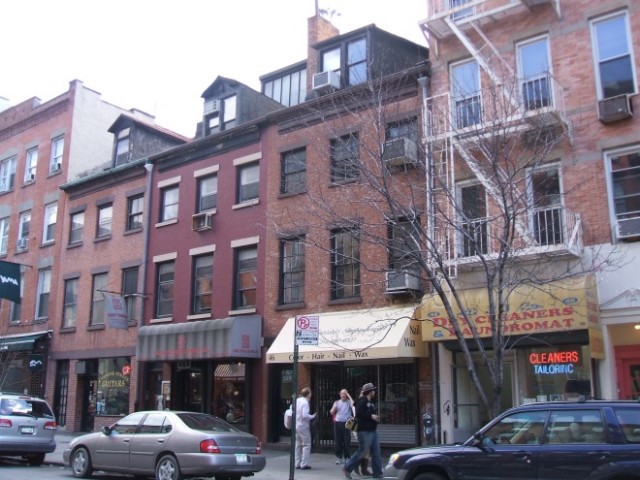
Abstract expressionist painter Jackson Pollock moved into 46 Carmine Street sometime in the 1940’s. According to rumors, Pollock chose the building in order to have 46–his lucky number–in his address.
This building was also once owned by Aaron Burr, the third Vice President of the United States. Burr is most famously known for shooting and killing his political rival Alexander Hamilton in one of the most famous personal conflicts in US history. The year-spanning personal conflict between the two men finally came to a head when Hamilton attacked Burr’s character in 1804 during the New York gubernatorial race. The politicians decided to lay their conflict to rest by challenging each other to a pistol duel in the Palisades in New Jersey, a site chosen in order to avoid New York’s strict laws against dueling. The New Jersey cliffs were often used as a dueling ground, and were the site of 18 documented duels between 1798–1845.
Though Hamilton took the first shot, he missed Burr. Burr then returned fire and fatally wounded the Vice President. Though Burr was never tried for the duel, Hamilton’s murder ended Burr’s political career. After the duel, Burr traveled to Europe in an attempt to make a new life for himself and restore his reputation. He then finally settled in New York and purchased 46 Carmine Street.
| internal | gDoc TBC |
| internal | Art Nerd article |
| internal | Apartment listing and history |
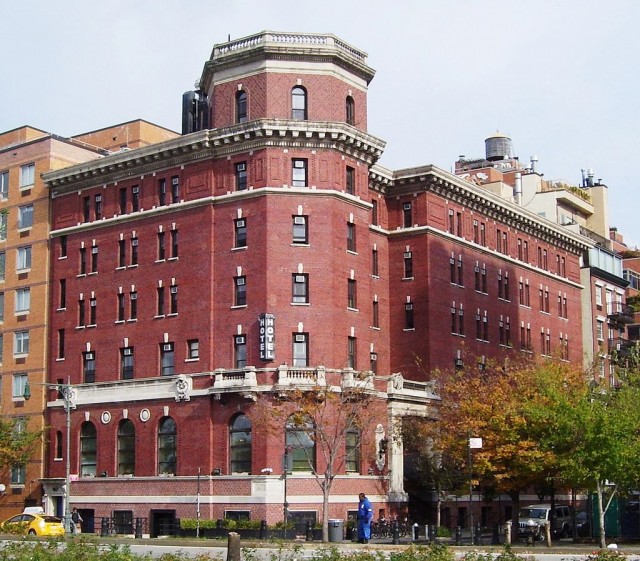
The Georgian-style building at 113 Jane Street was originally the American Seamen’s Friend Society Sailors’ Home and Institute. It served as a hotel for sailors and designed by William A. Boring. It was completed in 1908. After the RMS Titanic sunk in 1912, the Jane housed the survivors of the wreck during the American inquest into the sinking.
The YMCA purchased the building in 1944, running it as a hotel called the Jane West. In 2008, developers Sean MacPherson and Eric Goode renovated the structure and converted the old flop house into a luxury hotel.
| 1908 | Building is completed |
| 1912 | RMS Titanic sinks |
| 1944 | YMCA purchases building |
| 2000 | Becomes a New York City landmark |
| 2008 | Sean MacPherson and Eric Goode renovate |
| internal | gDoc TBC |
| internal | Art Nerd article |
| internal | Wikipedia |
| internal | The Jane website |
| internal | NYTimes article |
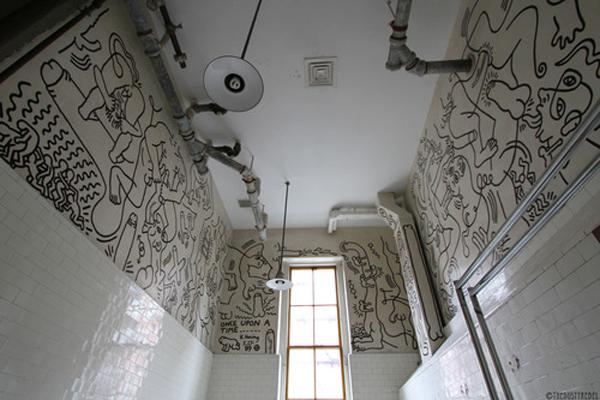
Keith Haring’s erotic 1989 mural “Once Upon a Time” was completed just months before he died of AIDS. It is located in the second floor men’s bathroom of the New York City’s Lesbian, Gay, Bisexual & Transgender Community Center at 208 West 13th Street. It is Haring’s most personal mural and it is one of a kind. In 2012, the mural was restored and open to the public.
Around the time of this mural’s completion, the artist also created a triptych altarpiece called “Life of Christ” for the Chapel of St. Columba at the Cathedral Church of Saint John the Divine, which is still on view at the church.
| tidbit | Keith Haring |
| sight | Keith Haring Altarpiece |
| sight | Keith Haring Swimming Pool Mural |
| sight | Mudd Club |
| sight | Two Dancing Figures |
| internal | gDoc TBC |
| internal | Blurb article |
| internal | Once Upon a Time is Restored |
| internal | Art Nerd article |
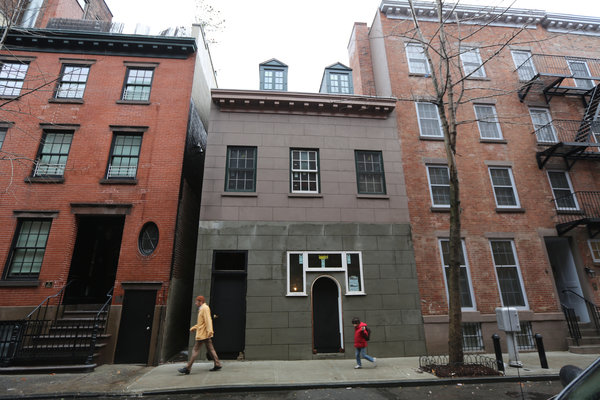
Chumley’s is a historic pub and former speakeasy at 86 Bedford Street in Greenwich Village , New York City. It was established in 1922 by the socialist activist Leland Stanford Chumley, who converted a former blacksmith’s shop near the corner of Bedford and Barrow Streets into a Prohibition-era drinking establishment. The speakeasy became a favorite spot for influential writers, poets, playwrights, journalists, and activists, including members of the Lost Generation and the Beat Generation movements.
Some features remain from Chumley’s Prohibition-era history. Notably, the Barrow Street entrance has no exterior sign, being located at the end of a nondescript courtyard (“The Garden Door”), while the Bedford Street entrance, which opens to the sidewalk, is also unmarked. Inside, Chumley’s is still equipped with the trap doors and secret stairs that composed part of its elaborate subterfuge.
It is also rumored that the term “86” originated when an unruly guest was escorted out the Bedford St. door, which held the address “86 Bedford St.” A different version referencing Chumley’s is offered in the book The History and Stories of the Best Bars of New York: “When the cops would very kindly call ahead before a [prohibition-era] raid, they’d tell the bartender to ’86’ his customers, meaning they should scram out the 86 Bedford door, while the police would come to the Pamela Court entrance.”
A plaque at the tavern, dated September 22, 2000, and placed by Friends of Libraries USA, stated that Chumley’s has been placed on a Literary Landmarks Register and goes on to describe Chumley’s as:
“A celebrated haven frequented by poets, novelists and playwrights, who helped define twentieth century American literature. These writers include Willa Cather, E.E. Cummings, Theodore Dreiser, William Faulkner, Ring Lardner, Edna St. Vincent Millay, Eugene O’Neill, John Dos Passos, and John Steinbeck.”
Posted on the walls of Chumley’s were the covers of books supposedly worked on there. Because of its historical significance, Chumley’s is a stopping-place for various literary tours.
Chumley’s has been closed since the chimney in its dining room collapsed on April 5, 2007. Promises to reopen have been made repeatedly, but progress in its reconstruction has been sporadic, and as of July 2012, work remained unfinished.
via Wikipedia

This permanent mural was executed by Haring at the City of New York Parks and Recreation public swimming pool at Carmine Street and Seventh Avenue in Greenwich village. Executed in 1987, the mural was restored by the Haring foundation 10 years later.
| internal | gDoc TBC |
| internal | Keith Haring Foundation |
| internal | Art Nerd article |
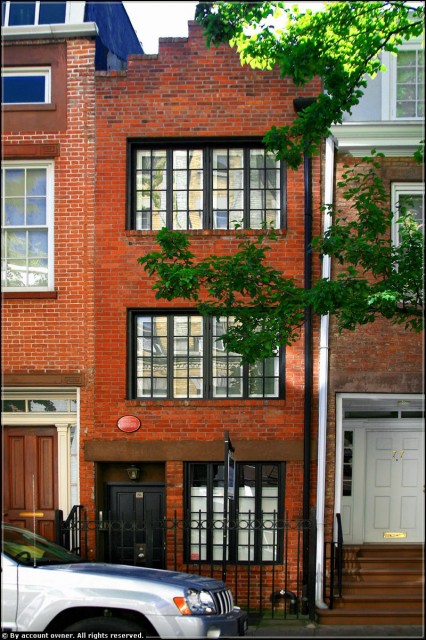
What is now known as the Millay House, at 75 1/2 Bedford St. in Manhattan’s West Village, was built around 1850 in a 9.5-foot-wide former passage for horse-drawn carriages. The interior is a foot narrower at the widest point, in the kitchen. The narrowest room, the master bedroom, measures just 7 feet 4 inches. In all, it spans 990 square feet.
The home is named after one of its famous tenants, the poet Edna St. Vincent Millay, who lived there in the 1920s. Actors Cary Grant and John Barrymore also lived there; as did the really wonderful author and illustrator William Steig (who wrote the original “Shrek!”), his wife, and his wife’s sister, famed anthropologist Margaret Mead.
via Yahoo! Homes
| internal | gDoc TBC |
| internal | Yahoo! Homes |
| internal | NY Architecture |
| internal | Town Real Estate |
| internal | The Millay House in Greenwich Village |
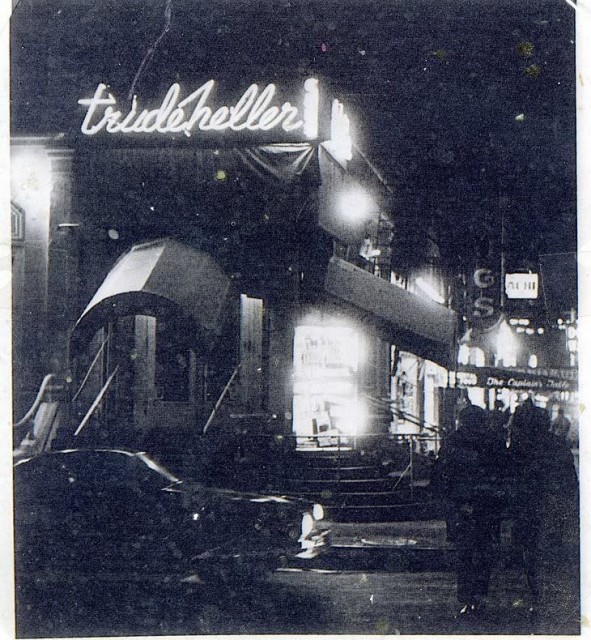
Trude Heller’s was a club in Greenwich Village, Manhattan, New York City and located at 6th Avenue and West 9th Street and operated from the early 1960s to the early 1980s. It has been described as the only truly “in” spot in Greenwich Village. Some of the acts that got their starts there were Duane and Gregg Allman of the Allman Brothers, Cyndi Lauper, and the Manhattan Transfer.
The club began its days in the early 1960s as a swinging Greenwich Village discothèque, run by a tough entrepreneur named Trude Heller.
In the 1960s, go-go dancers could be seen dancing along the walls. Some of the people that danced on the floor there were Salvador Dali, George Hamilton and Lynda Bird Johnson.
The end of the disco craze spelled the end of the club. Nowadays, Lenny’s sandwich chain is in the premises.
via Wikipedia
| internal | gDoc TBC |
| internal | Wikipedia |
| internal | Trude Club |
| internal |

The Jefferson Market Branch, New York Public Library, once known as the Jefferson Market Courthouse, is located at 425 Avenue of the Americas (Sixth Avenue), on the southwest corner of West 10th Street, in Greenwich Village, Manhattan, New York City, on a triangular plot formed by Greenwich Avenue and West 10th Street. It was originally built as the Third Judicial District Courthouse from 1874 to 1877, and was designed by architect Frederick Clarke Withers of the firm of Vaux and Withers.
The building got substantial use as a courthouse, as the Third Judicial District covered the Madison Square area, where the city’s entertainment district – The Tenderloin – was located. So heavy was the traffic, that the country’s first night court began there. Among the more noted people arraigned in the courthouse was Harry K. Thaw, the murderer of celebrity architect Stanford White.
The building ceased to be used as a courthouse in 1945; its future was uncertain, and it was in danger of being torn down. A group of community preservationists led by Margot Gayle and including E. E. Cummings and Lewis Mumford formed the Committee of Neighbors to Get the Clock on Jefferson Market Courthouse Started and campaigned to have the building converted into a library. In 1961, the New York Public Library agreed to the plan and architect Giorgio Cavaglieri was brought in to restore the exterior and redesign the building’s interior for its new use – one of the first adaptive reuse projects in the United States, and a signal event in the historic preservation movement. The restoration is estimated to have cost $1.4 million. The library opened in 1967, with the police court became the Children’s Reading Room, the Civil Court the Adult Reading Room. Budget cutbacks in 1974 caused the Board of Trustees of the New York Public Library to vote to close the branch, as well as two others. After an outcry from residents, the decision was rescinded one month later.
The building was listed on the National Register of Historic Places in 1972 and was declared a National Historic Landmark in 1977, both under the name “Third Judicial District Courthouse”.
edited from Wikipedia
| internal | gDoc TBC |
| internal | The Courthouse that Escaped the Gavel |
| internal | Wikipedia |
| internal | NY Architecture: Jefferson Market Library |
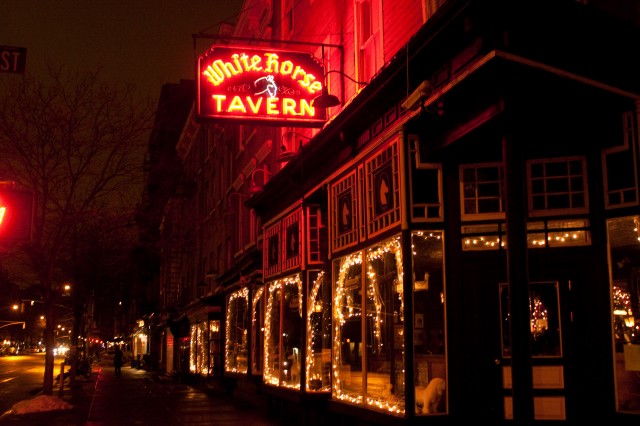
The White Horse Tavern, located in New York City’s borough of Manhattan at Hudson Street and 11th Street, is known for its 1950s and 1960s Bohemian culture. It is one of the few major gathering-places for writers and artists from this period in Greenwich Village (although the surrounding neighborhood is, more properly, the West Village) that remains open. The bar opened in 1880 but was known more as a longshoremen’s bar than a literary center until Dylan Thomas and other writers began frequenting it in the early 1950s.
The White Horse is perhaps most famous as the place where Dylan Thomas drank heavily, returned to the Chelsea Hotel, became ill, and died a few days later of unrelated causes. Other famous patrons include James Baldwin, The Clancy Brothers (who also performed at the establishment), Bob Dylan, Norman Mailer, Jack Kerouac, Jim Morrison, and Hunter S. Thompson.
About the same time, the White Horse was a gathering-place for labor members and organizers and socialists, as well. The Catholic Workers hung out here and the idea for the Village Voice was discussed here. The Village Voice original offices were within blocks of the White Horse. Much of the content was discussed here by the editors.
via Wikipedia
| internal | gDoc TBC |
| internal | White Horse Tavern |
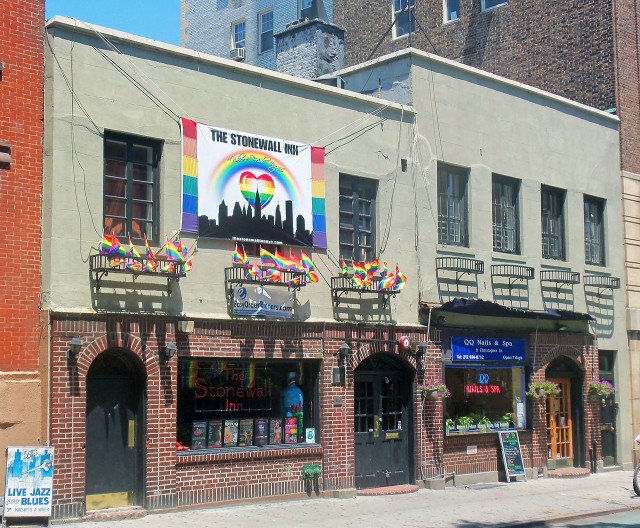
The Stonewall Inn, often shortened to Stonewall, is a gay tavern and recreational bar in New York City and the site of the Stonewall riots of 1969, which is widely considered to be the single most important event leading to the gay liberation movement and the modern fight for gay and lesbian rights in the United States.
The original Inn, which closed in 1969, was located at 51–53 Christopher Street, between West 4th Street and Waverly Place, in the Greenwich Village neighborhood of Manhattan. In 1990 a bar called “Stonewall” opened in the western half (53 Christopher Street). This was renovated and returned to its original name, “The Stonewall Inn”, in 2007. The buildings are both part of the New York City Landmarks Preservation Commission’s Greenwich Village Historic District, designated in 1969, and the Inn was designated a National Historic Landmark in 2000.
Originally constructed between 1843 and 1846 as stables, the property was turned into a restaurant in 1930. It remained a restaurant until it was gutted by fire in the mid 1960s.
On March 18, 1967, the Stonewall opened in the space. It was, during its time, the largest gay establishment in the U.S. and did a very good business, although, as with most gay clubs at the time, police raids were common. In late 1969, a few months after the rebellion that started on June 28 of that year, the Stonewall Inn closed.
Each year during the Pride March crowds gather outside the Stonewall Inn to celebrate its rich history.
via Wikipedia
| internal | gDoc TBC |
| internal | Stonewall Inn |
| internal | Stonewall Riots |
| internal | Stonewall Website |

Westbeth Artists Housing is a nonprofit housing and commercial complex dedicated to providing affordable living and working space for artists and arts organizations in New York City. Its campus comprises the full city block bounded by West, Bethune, Washington and Bank Streets in the West Village neighborhood of Manhattan, New York City; the complex is named for two of these streets, West and Bethune.
Westbeth is among the first examples of adaptive reuse of industrial buildings for artistic and residential use in the United States. It is a complex of 13 buildings in Manhattan’s West Village. The complex was originally the site of Bell Laboratories (1868–1966), one of the world’s most important industrial research centers and home to many inventions, including the vacuum tube, the condenser microphone, an early version of television, and the transistor. The complex was vacated by Bell Labs in the middle 1960s, and remained empty until the Westbeth project started later in the decade. Using seed money from the J.M. Kaplan Fund and help and encouragement from the National Council for the Arts (now the National Endowment for the Arts), an ambitious renovation project designed to create live-work spaces for 384 artists of all disciplines was initiated under the direction of developer Dixon Bain. The project was the first significant public commission of Richard Meier, who later won the Pritzker Prize for Architecture and who is still a significant figure in modern architecture. Westbeth opened in 1970 for artists, dancers, musicians, actors, writers and film makers.
In addition to its residential component, there are also large and small commercial spaces, performance spaces, and rehearsal and artists’ studios.
Westbeth was added to the National Register of Historic Places on December 8, 2009, after the Greenwich Village Society for Historic Preservation (GVSHP), using funds from the J.M. Kaplan Fund, commissioned historic preservationist Andrew Dolkart to write a nominating report to list Westbeth on the State and National Register of Historic Places.
A host of notable residents have lived at Westbeth, among them being photographer Diane Arbus, who committed suicide in 1971 in her Westbeth apartment.
edited from Wikipedia
| internal | gDoc TBC |
| internal | CultureNow |
| internal | Wikipedia |
| internal | Westbeth website |
| internal | An Enclave of Artists, Reluctant to Leave |

George Segal’s life-sized sculptural group of two men and two women is a monument to the gay rights movement, which began across the park at the Stonewall Inn. Segal based his sculptures on a gay and lesbian couple. Segal found models, and then took plaster casts of their bodies, which he then removed and were bronzed and painted white. Segal has used this technique to create some of his other sculptures, including “Commuters” at the Port Authority. This sculpture was commissioned in 1979 by Peter Putnam of the Mildred Andrews Fund, which provided funding for a monument to the Gay Rights movement. Bruce Voeller of the National Gay Rights Task Force had requested Peter Putnam to provide funding for a monument. George Segal’s design was chosen in 1982 with some controversy because he was not a gay artist and the figures were not racially or socially diverse.
| 1969 | Stonewall Riots |
| internal | gDoc |